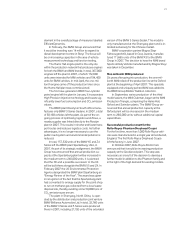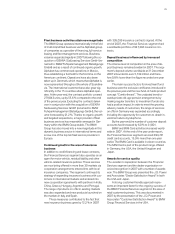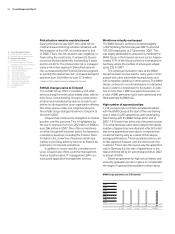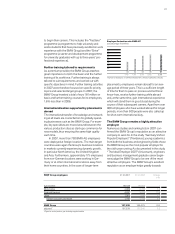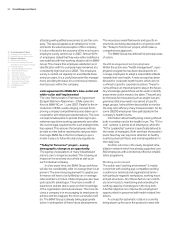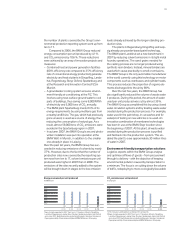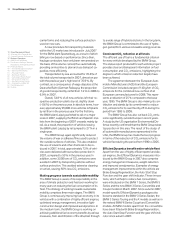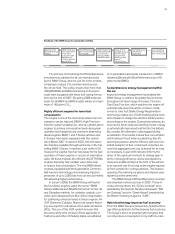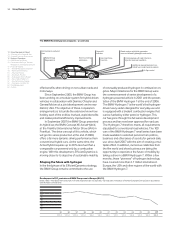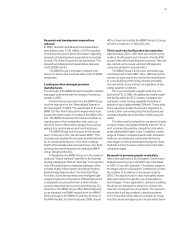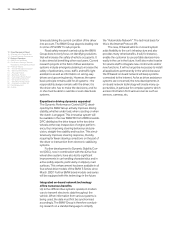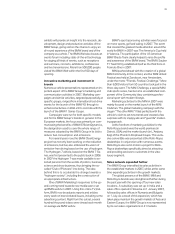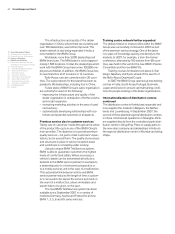BMW 2007 Annual Report Download - page 32
Download and view the complete annual report
Please find page 32 of the 2007 BMW annual report below. You can navigate through the pages in the report by either clicking on the pages listed below, or by using the keyword search tool below to find specific information within the annual report.
30 Group Management Report
10 Group Management Report
10 A Review of the Financial Year
13 General Economic Environment
17 Review of Operations
41 BMW Stock and Bonds
44 Disclosures relating to Takeover
Regulations and Explanatory Report
47 Financial Analysis
47 – Internal Management System
49 – Earnings Performance
51 – Financial Position
52 – Net Assets Position
55 – Subsequent Events Report
55 – Value Added Statement
57 – Key Performance Figures
58 – Comments on BMW AG
62 Risk Management
68 Outlook
Design for recycling – EU directive on
end-of-life vehicles
In 2007, the BMW Group pushed ahead with its strat-
egy of designing vehicles with subsequent recycling
in mind. One of the areas of focus during the year
was the development of a recycling concept for hy-
brid vehicles.
Over the last few years, a network of recovery
centres for end-of-life vehicles has been set up
throughout the European Union. Since 1 January
2007, customers in the EU have been able to return
their BMW, MINI or Rolls-Royce vehicles to these
recovery centres to be recycled free of charge. Dur-
ing 2007, the BMW Group increased the number
of end-of-life vehicle recovery centres by 7.8 %.
In order to meet the mandatory requirements
resulting from the EU End-of-life Vehicles Directive,
both in ecological and commercial terms, plans are
underway to increase the use of so-called Post
Shredder Technology (PST) in the future. After
completion of the vehicle shredder process, shred-
der residue fractions are sorted and sifted into their
various constituent materials such as metals, plastics
and minerals, in preparation for further processing.
On the basis of a large-scale trial performed in 2007
with approximately 500 vehicles from the current
model range, the BMW Group was able to demon-
strate that, with the aid of PST, it meets the manda-
tory requirements relating to the recycling of end-of-
life vehicles.
The EU End-of-life Vehicles Directive also re-
quires that recycled materials are used in new vehi-
cles. This involves recycling waste materials from
production processes or those won from end-of-life
parts. In 2007, experts at the BMW Group suc-
ceeded in extending the use of recycled materials
to other components, such as the mountings for
bumpers and soundproofing covers for diesel
engines. The use of recycled materials in individual
models was also extended to other model series.
For example, the wheel arch liners produced from
recycled bumper fascia previously used in the
BMW 1 Series and BMW 3 Series are also being
used in the X5 from 2007 onwards.
Group-wide environmental protection
measures set standards
The BMW Group’s Clean Production philosophy
is based on the idea of preventative environmental
protection. Certified environmental management
systems throughout the BMW Group have been in
place since 1996. These systems serve as the basis
for coordinating and optimising the Group’s environ-
ment protection activities and hence the careful con-
sumption of resources. The certification audit of the
production function, in accordance with DIN EN ISO
9001 and DIN EN ISO 14001, was successfully con-
cluded in December 2007, once again confirming
the high standards prevailing at all locations in the
field of quality and environmental protection. Spe-
cialist external auditors (the German TÜV organisa-
tion) once again confirmed a very high standard
in terms of quality and environmental performance,
highlighting several processes as exemplary. A
new objectives-based process was introduced for
production in 2007, making it easier to measure and
manage the effective use of resources. Perform
ance
indicators relevant to environmental protection, such
as energy consumption and waste levels at the BMW
Group production sites, are measured and reported
on a monthly basis and a so-called environment effi-
ciency ratio is calculated. The aim is to improve the
efficiency ratio by 5 % a year. The new
eco-facts IT
system was implemented in mid-2007.
This system
collates data for some 150 environmentally relevant
performance indicators and is therefore an extremely
useful tool for managing environmental protection
activities. The introduction of eco-facts meant that
Volatile organic compounds (VOC) per unit produced
in kg/unit
3.25
3.00
2.75
2.50
2.25
2.00
03
2.88
04
2.26
05
2.07
06
2.04
07
2.36
* Basis for data expanded in 2007 from ten to 17 locations: Munich, Dingolfing,
Landshut, Regensburg, Leipzig, Steyr, Rosslyn, Spartanburg, Hams Hall, Oxford
and, since 2007, Berlin (brake disc production), Eisenach, Swindon, Goodwood,
Rayong (assembly), Chennai (assembly) and BMW Brilliance in Shenyang.
*
Process waste water per unit produced
in m3/unit
1.00
0.90
0.80
0.70
0.60
0.50
03
0.98
04
0.83
05
0.76
06
0.67
07
0.64
* Basis for data expanded in 2007 from ten to 17 locations: Munich, Dingolfing,
Landshut, Regensburg, Leipzig, Steyr, Rosslyn, Spartanburg, Hams Hall, Oxford
and, since 2007, Berlin (brake disc production), Eisenach, Swindon, Goodwood,
Rayong (assembly), Chennai (assembly) and BMW Brilliance in Shenyang.
*



